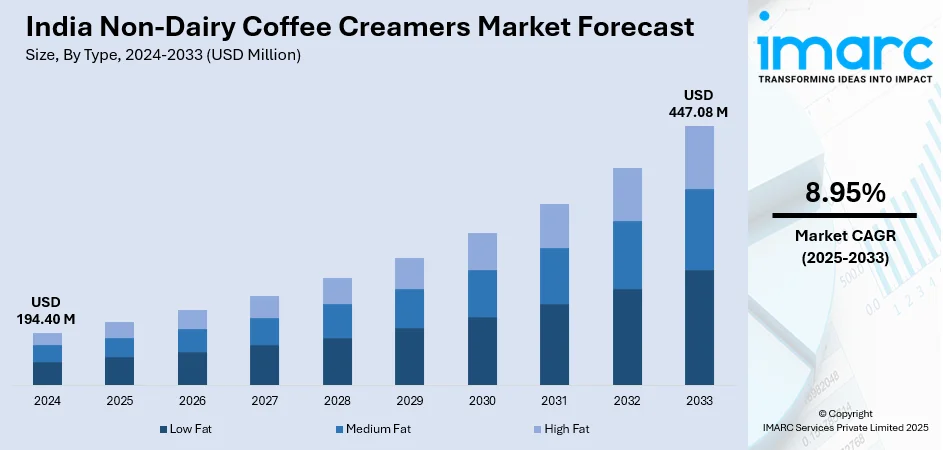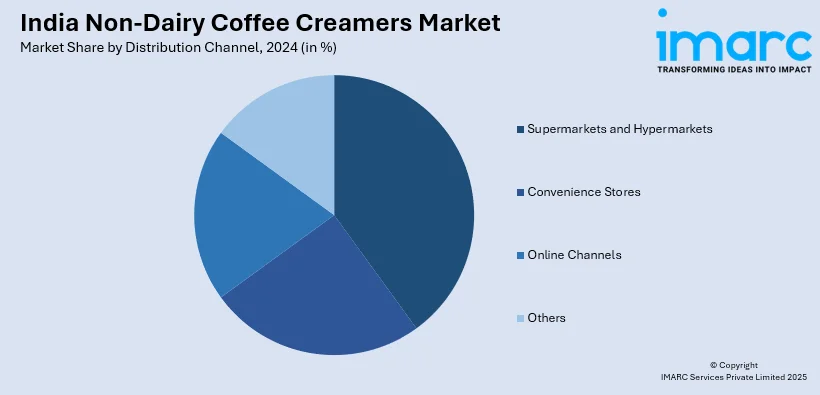
India Non-Dairy Coffee Creamers Market Size, Share, Trends and Forecast by Type, Form, Source, Flavor, Distribution Channel, and Region, 2025-2033
India Non-Dairy Coffee Creamers Market Overview:
The India non-dairy coffee creamers market size reached USD 194.40 Million in 2024. Looking forward, IMARC Group expects the market to reach USD 447.08 Million by 2033, exhibiting a growth rate (CAGR) of 8.95% during 2025-2033. The market is expanding due to rising lactose intolerance, plant-based preferences, and café culture growth. The demand is driven by vegan, low-fat, and flavored options, with key players investing in innovation and distribution to capture market share.
|
Report Attribute
|
Key Statistics
|
|---|---|
|
Base Year
|
2024 |
|
Forecast Years
|
2025-2033
|
|
Historical Years
|
2019-2024
|
| Market Size in 2024 | USD 194.40 Million |
| Market Forecast in 2033 | USD 447.08 Million |
| Market Growth Rate (2025-2033) | 8.95% |
India Non-Dairy Coffee Creamers Market Trends:
Growing Consumer Preference for Plant-Based and Lactose-Free Alternatives
The India non-dairy coffee creamers industry is actively undergoing robust expansion, mainly influenced by the intensifying inclination towards lactose-free as well as plant-based substitutes. A significant section of the population is lactose-intolerant, driving the shift toward dairy-free options. For instance, as per industry reports, lactose intolerance is most prevalent in Asian nations. In line with this, around 61% of the individuals in India are lactose intolerant. Additionally, changing dietary habits, driven by health-conscious consumers, are promoting the adoption of plant-based products. Soy, almond, oat, and coconut-based creamers are gaining traction due to their perceived health benefits, including lower cholesterol and improved digestion. The expansion of veganism, along with increased awareness of animal welfare and sustainability concerns, is further accelerating market growth. Leading manufacturers are introducing fortified and flavored non-dairy creamers to cater to evolving consumer preferences. With the rising influence of global food trends and increasing disposable incomes, India’s non-dairy creamer market is poised for steady expansion. Growth in cafés, quick-service restaurants (QSRs), and at-home coffee consumption is also contributing to the demand for high-quality, non-dairy creamer options.

To get more information on this market, Request Sample
Expansion of E-Commerce and Specialty Retail Channels
E-commerce and specialty retail are playing a crucial role in the expansion of the India non-dairy coffee creamer market. Online platforms offer a convenient purchasing experience, allowing consumers to compare prices, explore a broad variety of products, and access reviews before forming decisions. The increasing penetration of digital payment systems and rapid urbanization have contributed to the surge in online grocery shopping, making non-dairy creamers more accessible across diverse regions. In addition, specialty retail stores and premium supermarket chains are dedicating shelf space to plant-based and lactose-free creamers, catering to health-conscious consumers seeking high-quality alternatives. Direct-to-consumer (DTC) brands are also capitalizing on the online marketplace by offering subscription models and personalized recommendations. As consumer preferences shift toward healthier and sustainable choices, the growth of e-commerce and organized retail channels is anticipated to enhance product visibility, drive sales, and support further market expansion in India. For instance, IMARC Group reports that e-commerce industry across India is anticipated to grow to USD 259 Billion by the year 2032, exhibiting a 29.3% of the growth rate during 2024 to 2032.
India Non-Dairy Coffee Creamers Market Segmentation:
IMARC Group provides an analysis of the key trends in each segment of the market, along with forecasts at the region level for 2025-2033. Our report has categorized the market based on type, form, source, flavor, and distribution channel.
Type Insights:
- Low Fat
- Medium Fat
- High Fat
The report has provided a detailed breakup and analysis of the market based on the type. This includes low fat, medium fat, and high fat.
Form Insights:
- Powder
- Liquid
A detailed breakup and analysis of the market based on the form have also been provided in the report. This includes powder and liquid.
Source Insights:
- Almond
- Coconut
- Soy
- Others
A detailed breakup and analysis of the market based on the source have also been provided in the report. This includes almond, coconut, soy, and others.
Flavor Insights:
- French Vanilla
- Caramel
- Hazelnut
- Irish Creme
- Others
A detailed breakup and analysis of the market based on the flavor have also been provided in the report. This includes French vanilla, caramel, hazelnut, Irish creme, and others.
Distribution Channel Insights:

- Supermarkets and Hypermarkets
- Convenience Stores
- Online Channels
- Others
A detailed breakup and analysis of the market based on the distribution channel have also been provided in the report. This includes supermarkets and hypermarkets, convenience stores, online channels, and others.
Regional Insights:
- North India
- South India
- East India
- West India
The report has also provided a comprehensive analysis of all the major regional markets, which include North India, South India, East India, and West India.
Competitive Landscape:
The market research report has also provided a comprehensive analysis of the competitive landscape. Competitive analysis such as market structure, key player positioning, top winning strategies, competitive dashboard, and company evaluation quadrant has been covered in the report. Also, detailed profiles of all major companies have been provided.
India Non-Dairy Coffee Creamers Market News:
- In November 2024, abCoffee, one of the leading India-based coffee chains, unveiled the first non-dairy beverages that are coconut-based. Commercially available in above 75 retail outlets of India, the portfolio features creamy texture of coconut milk with specialty coffee mixtures, addressing the demand of customers navigating for dairy-free options.
- In September 2024, Starbucks, with several outlets across India, unveiled its oat milk-based new drinks. It includes Salted Pecan Cream Cold Foam that is available as non-dairy too, Iced Pecan Crunch Oatmilk Latte that is made of oat milk with non-dairy foam of vanilla, and Pecan Crunch Oatmilk Latte.
India Non-Dairy Coffee Creamers Market Report Coverage:
| Report Features | Details |
|---|---|
| Base Year of the Analysis | 2024 |
| Historical Period | 2019-2024 |
| Forecast Period | 2025-2033 |
| Units | Million USD |
| Scope of the Report |
Exploration of Historical Trends and Market Outlook, Industry Catalysts and Challenges, Segment-Wise Historical and Future Market Assessment:
|
| Types Covered | Low Fat, Medium Fat, High Fat |
| Forms Covered | Powder, Liquid |
| Sources Covered | Almond, Coconut, Soy, Others |
| Flavors Covered | French Vanilla, Caramel, Hazelnut, Irish Creme, Others |
| Distribution Channels Covered | Supermarkets and Hypermarkets, Convenience Stores, Online Channels, Others |
| Regions Covered | North India, South India, East India, West India |
| Customization Scope | 10% Free Customization |
| Post-Sale Analyst Support | 10-12 Weeks |
| Delivery Format | PDF and Excel through Email (We can also provide the editable version of the report in PPT/Word format on special request) |
Key Benefits for Stakeholders:
- IMARC’s industry report offers a comprehensive quantitative analysis of various market segments, historical and current market trends, market forecasts, and dynamics of the India non-dairy coffee creamers market from 2019-2033.
- The research report provides the latest information on the market drivers, challenges, and opportunities in the India non-dairy coffee creamers market.
- Porter's five forces analysis assist stakeholders in assessing the impact of new entrants, competitive rivalry, supplier power, buyer power, and the threat of substitution. It helps stakeholders to analyze the level of competition within the India non-dairy coffee creamers industry and its attractiveness.
- Competitive landscape allows stakeholders to understand their competitive environment and provides an insight into the current positions of key players in the market.
Key Questions Answered in This Report
The India non-dairy coffee creamers market was valued at USD 194.40 Million in 2024.
The India non-dairy coffee creamers market is projected to exhibit a CAGR of 8.95% during 2025-2033, reaching a value of USD 447.08 Million by 2033.
The India non-dairy coffee creamers market is driven by rising lactose intolerance awareness, growing vegan and plant-based lifestyles, and increasing coffee consumption. Urbanization, busy lifestyles, and demand for convenient, shelf-stable alternatives further fuel adoption. Expanding café culture and product availability through online and retail channels also support market growth.
Need more help?
- Speak to our experienced analysts for insights on the current market scenarios.
- Include additional segments and countries to customize the report as per your requirement.
- Gain an unparalleled competitive advantage in your domain by understanding how to utilize the report and positively impacting your operations and revenue.
- For further assistance, please connect with our analysts.
 Request Customization
Request Customization
 Speak to an Analyst
Speak to an Analyst
 Request Brochure
Request Brochure
 Inquire Before Buying
Inquire Before Buying




.webp)




.webp)












